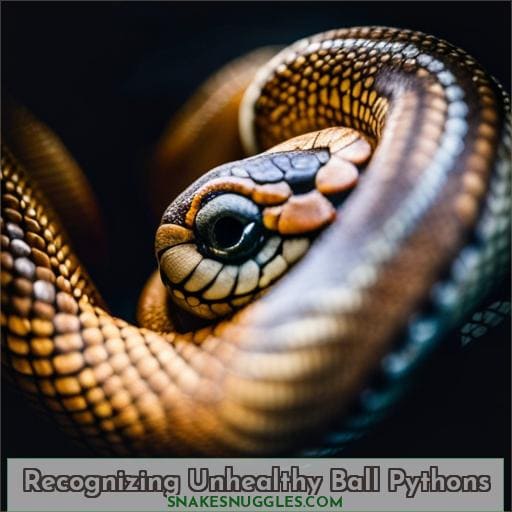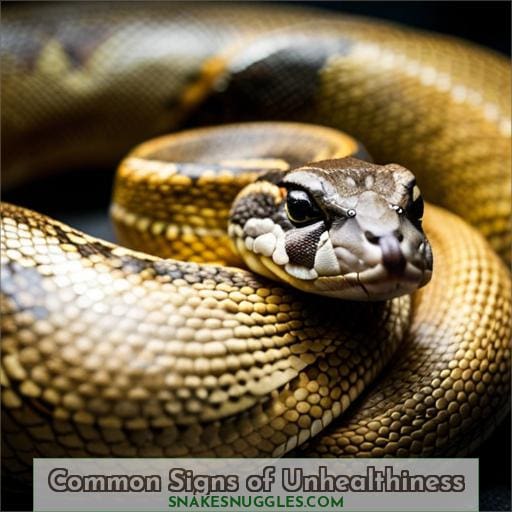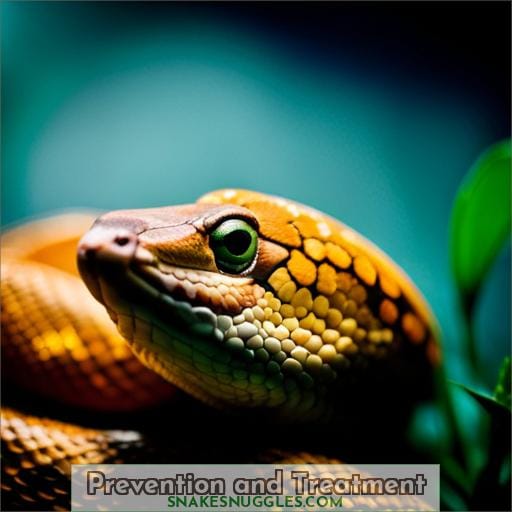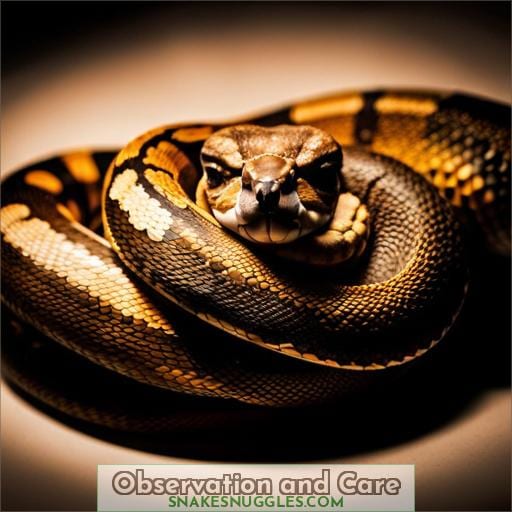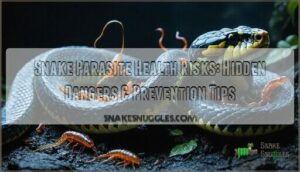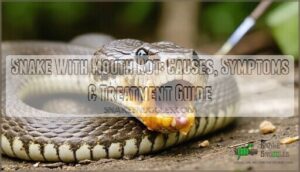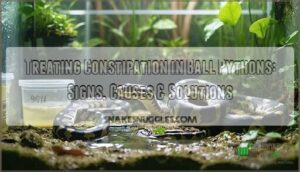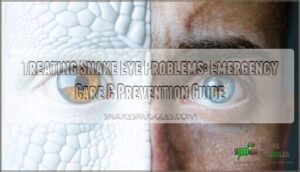This site is supported by our readers. We may earn a commission, at no cost to you, if you purchase through links.
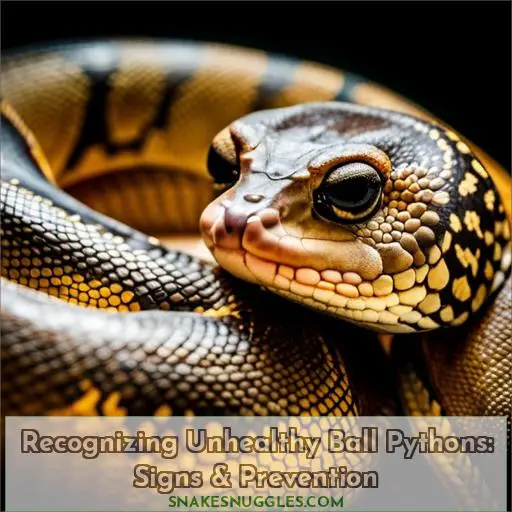 Knowing the signs of an unhealthy ball python is essential for any pet owner. Unhealthy snakes can quickly become very sick and even die if left untreated.
Knowing the signs of an unhealthy ball python is essential for any pet owner. Unhealthy snakes can quickly become very sick and even die if left untreated.
In this article, we’ll cover some common signs that your ball python may be unwell so you can take action to get them back on track towards a healthy life. From dehydration and lack of appetite to breathing difficulties or unusual lumps or swellings, it’s important to look out for these physical symptoms in order to identify when something is wrong with your snake quickly before their condition worsens further.
We’ll also provide tips on prevention methods and treatments as well as specific health issues such as Respiratory Infection (RI) or Mouth Rot (Stomatitis), so that you have the tools needed at hand should they become necessary.
Table Of Contents
Key Takeaways
- Recognize signs of stress and maintain a suitable environment.
- Address issues promptly with professional help.
- Regularly check for wellness, hydration, and shedding.
- Observe behavior and appearance for any abnormalities.
Recognizing Unhealthy Ball Pythons
It’s important to be aware of the subtle changes in a ball python’s behavior or appearance that can indicate an underlying health problem. Signs such as mouth rot, weight issues, parasite infestations, and neurological problems may not always be visible at first glance.
Stress management is also essential for good health. Head rubbing can lead to raw spots and sores if left untreated. Abnormal shedding due to environmental factors is another sign of illness. Focus on eye caps and tail while increasing humidity or providing soaking sessions when needed.
A vet visit should be considered if there are signs like no eating, excessive shedding, difficulty moving, or open wounds present. Early diagnosis will allow swift action and treatment before any serious complications occur.
When it comes to dehydration, look out for sunken eyes, wrinkled skin, along with lethargy. These could all point towards this condition, so prompt attention must be paid here too.
Temperature tolerance plays a key role in reptile wellness, so maintain optimal enclosure temperature at all times.
Lastly, keep an eye on their hiding patterns. Moderate amounts are healthy, but excessive movement might signal stress levels creeping up, which needs addressing quickly too!
Common Signs of Unhealthiness
Recognizing signs of an unhealthy ball python is essential for their well-being. Common indicators to look out for include a lack of appetite, abnormal posture, severe weight loss, dehydration, inactivity/lethargy, and more.
Be sure to pay close attention to changes in your snake’s behavior or appearance so that you can take the necessary steps if they become unwell.
Lack of Appetite
Recognize that a loss of appetite can be dangerous, especially if they’re underweight. A decrease in appetite is often due to stress, temperature or humidity changes, shedding cycles, and old age. Proactive care involves identifying symptoms early on and adjusting the diet accordingly to ensure their health remains optimal.
Stress relief through providing a calm environment free from excessive handling and noise is essential for preventing illnesses such as respiratory infection or sepsis, which may lead to inclusion body disease (IBD).
Regularly checking for mites/ticks around the eyes can further prevent parasite infestations, leading to skin problems like sores or raw spots.
Abnormal Posture
Look for your ball python’s head posture – if it appears to be stargazing, this could indicate a respiratory issue. Abnormal postures are also important stress signals and can indicate Inclusion Body Disease (IBD).
Make sure you keep an eye on any changes in your snake’s behavior or scale color that could signify tumors or infections. Proper symptom management is key for disease diagnosis and the long-term health of the healthy ball python.
Be aware of abnormal behavior in snakes, as early detection can help prevent further complications from developing illnesses like IBD, mouth rot, and parasite infestations.
Severe Weight Loss
Be alarmed when noticing drastic weight loss, prominent bony spines, and a lack of appetite in your ball python – all indicators that something is seriously wrong. These symptoms can be caused by dietary needs, poor nutrition, or underlying illnesses such as respiratory issues.
To ensure optimal health for your pet, observe their diet, stress levels, and shedding process. This will help prevent snake weight loss due to reptile health concerns. Maintain a balance between food intake and activity.
Watch carefully for signs of lethargy or changes in behavior, as this may point to an issue with the animal’s well-being. Monitor closely any changes in size or weight over time so you can act quickly if needed.
Dehydration
Check for signs of dehydration in your ball python, such as cloudy and sunken eyes, weight loss, and lack of appetite. Causes may include stress or temperature extremes. Dehydration can lead to other health issues or death, so it’s important to address promptly with hydration tips like providing warmth and humidity.
If symptoms persist after adjusting the environment, it is recommended to visit a vet. Look out for skin discoloration that could indicate IBD or sepsis, which are near-death conditions. Reptiles require specific hydration levels, so seek professional veterinary care if unsure about your pet reptile’s health needs.
Snake care involves closely monitoring behaviors. Be aware of any unusual lumps or swellings, as they may signal infection or tumors that require swift action and treatment from a vet specialist.
Inactivity/Lethargy
Unusual lethargy during peak activity times can be a sign of potential issues with your ball python. It’s important to do regular check-ups and detect any changes in behavior, such as sleeping more than usual or not interacting with its environment.
Lethargy may result from illness triggers, environmental factors, weight loss, or other health complications that require vet visits for further diagnosis and treatment options.
Ball pythons typically hide when they’re feeling under the weather. Observe their hiding behavior carefully if you suspect they are unwell.
Stress in snakes should also be monitored carefully. Provide them an appropriate habitat where temperature extremes are avoided so stress can be managed effectively to maintain good health for your beloved pet reptile!
Breathing Difficulties
Rapid and deep breathing can be a sign of failing organs in your pet reptile, with 1 out of 3 ball pythons suffering from respiratory infections. Lung infections cause difficulty with breathing as mucus clogs the airways, leading to oxygen deprivation.
To recognize these problems in snakes, pay attention to their shedding patterns and clear eyes after shedding. If you notice any changes or irregularities such as unusual sounds while they breathe or wheezing/gurgling noises, then it’s important for your snake’s health that you seek medical help immediately.
Additionally, check for signs like stargazing, which could indicate more serious issues such as inclusion body disease (IBD).
Poor Coordination
You may notice your beloved ball python struggling to keep their balance, a sign of poor coordination. This could be due to neurological issues such as Inclusion Body Disease (IBD). Poor coordination can lead to paralysis and should not be overlooked.
Stress also plays a role in poor coordination. If your snake appears agitated or shows signs of head rubbing, it might indicate an underlying health issue that needs attention.
Ensure active snakes have good appetites and are free from stress by providing them with an ideal environment for optimal wellbeing.
Unusual Lumps or Swellings
Lumps or swellings on your ball python’s body can indicate underlying health issues. Swellings may be visible after shedding, which could suggest skin problems or other diseases. It is important to take notice of the characteristics and size of any lumps as this will help with diagnosis.
A vet visit is needed for an accurate assessment and treatment options. Diagnostic tests should be performed if required; these are necessary to determine the cause of swelling before it becomes more serious over time.
Veterinary care for reptiles can provide advice in preventing further issues such as shedding problems due to incorrect humidity levels in their environment, which may lead to unhealthy signs developing later on down the line like mite infestations or mouth rot (stomatitis).
Paying attention to warning signs early on will give you a better chance at a successful outcome when caring for your pet reptile’s health!
Regurgitation
If you notice your ball python regurgitating its food, it could be a sign of an underlying illness. Studies show that over 75% of regurgitation cases in pet snakes are caused by some form of disease or infection.
It is important to take your snake to the vet for proper diagnosis and treatment options as soon as possible. Prevention strategies such as hydrating snakes regularly, maintaining proper enclosure temperature and humidity, providing adequate hiding spaces, avoiding overcrowding, and managing stress can all help reduce the chances of sickness in ball pythons.
Regularly check on the shedding process too; healthy sheds usually come off in one piece! Overweight or underweight issues should also be addressed promptly with correct nutrition guidelines for all ages from experts like vets or certified reptile keepers.
Taking proactive steps when caring for your sick snake will ensure they have a better chance of surviving any health issue encountered along their journey!
Change in Skin Coloration or Appearance
Sudden changes in skin coloration can be an indication of underlying health issues. Ball pythons are particularly sensitive to environmental stress, and a change in their normal coloring may suggest that something is out of balance.
It’s important to differentiate between hibernation patterns and signs of illness. The latter will not improve with warming up temperatures or other attempts at stimulating activity. Color changes could also indicate more serious problems such as infections, toxins, or tumors.
If you’re concerned about your pet snake’s health status, it’s best to consult a vet. Pay close attention for any abnormal behaviors when caring for your ball python, as stress indicators include head rubbing, which can lead to raw spots on the head scales and sores along its body.
Isolative Behavior
Be aware of a ball python’s isolative behavior, which can indicate underlying health issues. Look out for hidden signs like withdrawing from interactions, refusing to eat or drink, and avoiding contact with its handler.
Isolated cases could be due to environmental factors such as temperature extremes or improper housing. If noticed early enough, they may be easily preventable by making changes in the snake’s environment and handling methods.
Warning signs include head rubbing against objects as a sign of stress that can lead to raw spots and sores on the skin. This should not be ignored! If you notice any odd behavior, it is crucial that you take preventative measures right away to ensure your pet’s well-being.
Prevention and Treatment
If your ball python is showing signs of unhealthiness, it is essential to take swift action. Knowing how to distinguish death from hibernation, detect dehydration, manage stress and temperature tolerance, as well as when to visit the vet, can help save a dying ball python.
Early intervention is key for prevention and treatment of any potential health issues.
Saving a Dying Ball Python
Take prompt action to save a dying ball python by minimizing stress, providing consistent temperature and humidity, and seeking professional help if necessary. Predicting decline through preventative care is key. Environmental factors such as temperature drops should be monitored for hibernation versus death; vet visits may also be required.
Distinguishing Death From Hibernation
During colder temperatures, it can be difficult to tell when a Ball Python is in hibernation versus passing away, so pay attention to the signs. Unresponsiveness and lack of movement are clues that your pet may have entered winter hibernation.
However, if there’s no reaction after prodding or offering food, then death should be suspected. Utilize seasonal changes as an indicator for potential hibernation. Decreased activity during cooler months might mean they’re entering their period of dormancy, while a sudden decrease suggests something more serious has occurred.
Pay close attention to other signals such as respiratory difficulty or uncoordinated movements, which could also signify death rather than decline due to the restful season.
Detecting Dehydration
Check for signs of dehydration, such as sunken eyes, wrinkled skin, and lethargy, to quickly address the issue.
Monitor humidity levels within an appropriate temperature range at all times. Ensure proper hydration by providing water bowls that are both accessible and secure on a frequent basis. Soaking can be beneficial, but it should not become routine or excessive, as it could lead to other health complications like pneumonia or scale rot if done too often or incorrectly administered.
Lastly, be sure to check your ball python’s weight regularly. Any drastic changes in either direction may indicate dehydration, so pay attention!
Lethargy Causes
Lethargy can be caused by factors like shedding cycles, temperature extremes, or inadequate food intake. Stress triggers such as improper housing and noise levels also contribute to a ball python becoming lethargic.
Diet changes may lead to paralysis risks if not addressed quickly enough. Environmental factors should always be monitored closely in order for the snake’s temperature requirements to stay consistent.
When temperatures fluctuate drastically, it can cause a ball python great distress, which leads them into inactive states.
Managing Stress
To help your ball python stay healthy, create a calm and peaceful environment to minimize stress. Ensure the temperature is comfortable, noise levels are low, and it has enough space to hide away if needed.
Monitor your snake’s behavior for signs of stress such as head-rubbing or excessive hiding; these should be addressed quickly with preventative care. Proper housing can reduce environmental factors that may lead to elevated stress levels in your pet reptile, so make sure you provide them with an enriching habitat suitable for their needs.
Temperature Tolerance
Be aware that ball pythons can tolerate temperatures as low as 50°F, so make sure you adjust the environment accordingly. This is important to prevent temperature extremes, which can cause stress in snakes and lead to other health issues.
If your snake has any of these symptoms, it’s best to seek professional help for lab testing and treatment. Additionally, be mindful of humidity levels since improper housing or lack of water may result in incomplete shedding or skin problems such as mites.
Take swift action if you notice any signs that could indicate an unhealthy ball python.
When to Visit the Vet
If you notice any drastic changes in your pet’s eating, weight, movement, or appearance, it is important to take them to the vet right away. Signs of illness such as no appetite or lethargy could mean serious health issues and require swift action for prevention and diagnosis.
Temperature extremes can be a major factor in stress-related illnesses, so make sure their environment is consistent.
Swift Action and Treatment
Time is of the essence when it comes to treating an ailing ball python, so take swift action if you suspect any health issues. A vet visit should be first on your list for diagnosis and treatment options. It’s equally important that timely care is taken in managing environmental factors such as temperature, humidity, and stress, which can all contribute to poor health.
The following points are key:
- Treatment Options: Seek professional help quickly for the best results.
- Vet Diagnosis: Get lab tests done for accurate diagnosis.
- Timely Care: Delay could lead to complications or death.
- Stress Management: Create a calm environment with minimal handling.
- Environmental Factors: Ensure warmth and humidity levels remain consistent.
Take the necessary steps outlined above and observe closely any signs of illness in order to ensure your pet’s well-being! Regular checkups from a qualified veterinarian will also help prevent many potential problems before they arise.
Specific Health Issues and Solutions
An unhealthy ball python might display a variety of symptoms, such as respiratory infection (RI), mouth rot (stomatitis), stress in snakes, skin problems, shedding issues, and twitching or neurological issues.
Further health concerns include inclusion body disease (IBD) and weight-related troubles. To ensure your pet’s well-being, it is vital to be aware of these conditions and take swift action for treatment.
Respiratory Infection (RI)
Regularly check for signs of Respiratory Infection (RI) in your ball python, such as stargazing or open-mouth breathing. RI can be prevented by maintaining optimal enclosure temperature and humidity. Symptoms include bad odor, pink/red mouth, oozing wound, and lack of appetite.
Lab tests are needed for diagnosis, with antibiotics used for treatment to reduce the risk of sepsis. Quarantine is essential to limit the spread of infection, while proper care must be taken when handling an infected snake to avoid further contamination.
Mouth Rot (Stomatitis)
Mouth rot is a common health issue in ball pythons, with nearly half of all cases needing lab testing for diagnosis. Symptoms can include an unpleasant odor, pink or red mouth tissue, oozing wounds, and lack of appetite.
If left untreated, it can lead to sepsis, which could be fatal. So, early diagnosis is essential. Preventative care and veterinary advice are also important steps. Tooth loss may occur due to bacterial growth, as well as other signs that the infection has become severe, such as raised scales on the lips or underneath them and excessive salivation.
Providing your snake with optimal temperatures, combined with regular vet check-ups, should help keep them healthy.
Stress in Snakes
You may notice your ball python head-rubbing, a stress sign that can lead to raw spots and sores. Stress in snakes is caused by improper housing, temperature extremes, noise, or cohabitation. Managing stress requires maintaining a calm environment with minimal handling and movement.
Temperature tolerance for reptiles must be considered. Ball pythons can survive low temperatures as low as 50°F. To reduce the risk of stressing out your snake, it’s important to provide an enclosure that meets their needs and reflects natural behaviors like hiding places or burrows so they feel secure in their space.
Stress relief can also come from providing regular soaking sessions, which help keep humidity levels up for healthy shedding cycles too! Maintain optimal environmental conditions to ensure proper health throughout all stages of life – prevention is key!
Skin Problems
Check your pet’s ball python for parasites, such as ticks and mites; these can cause irritation.
- Maintain optimal humidity in the enclosure.
- Check around the eyes for mites often.
- Use Provent a Mite spray regularly as a prevention.
- Look out for raw spots and bacterial infections that may require antibiotics. If left untreated, sepsis could be fatal to your precious reptile pet! Be sure to monitor their health closely while providing a safe environment with proper humidity levels at all times.
Shedding Problems
Shedding problems can occur due to environmental factors, and if not addressed, they can lead to health issues. Pay attention to things such as humidity, temperatures, and enclosure size that may trigger shedding.
Providing a warm, humid environment with access to water helps the snake in its shedding process.
Timing is also important. A ball python typically sheds every 4 weeks or so, but this varies depending on age and growth rate. Unhealthy shedding causes stress for the snake, which results in skin irritation or infection.
Twitching and Neurological Issues
Twitching and neurological issues can be a sign of underlying health concerns in your pet, so watch for confused movements or potential paralysis.
Inclusion Body Disease (IBD) is another risk that can cause corkscrewing, balance issues, and stargazing behavior.
Additionally, twitching could be caused by environmental factors such as temperature extremes or insufficient food intake, stressing the snake out.
Monitor your ball python’s behavior closely for signs of ill-health, then take swift action with professional help if necessary!
Inclusion Body Disease (IBD)
Be aware of the danger that Inclusion Body Disease (IBD) poses – it’s a fatal neurological disease with symptoms like corkscrewing, balance issues, and stargazing. It can occur in any age ball python and is often asymptomatic until it becomes advanced.
IBD requires lab testing for diagnosis, antibiotics for treatment, and careful quarantine to prevent spread. Prevention focuses on maintaining optimal enclosure temperature and humidity levels, and avoiding stressors – all contributing factors to its occurrence and severity when contracted by your pet snake.
Weight Issues
Weight issues can be an indication that something is wrong, so it’s important to understand how much your ball python should weigh and monitor any changes. If you suspect either of these problems, take your pet for a vet visit immediately.
Overfeeding leads to obesity, while underfeeding causes the snake to become underweight. Lack of food intake or improper feeding guidelines can also lead to weight loss in snakes. Stressful environments, such as temperature extremes or cohabitation, may cause additional health issues resulting from head rubbing.
This could lead to raw spots and sores on the skin surface if not managed correctly or promptly addressed by a professional carer/vet.
Observation and Care
As a ball python owner, it’s important to be aware of the signs and symptoms that could indicate an unhealthy snake. Pay close attention to clear eyes and active behavior. Notice healthy hiding patterns and appetite changes.
Listen for any breathing sounds. Also, note scale coloration when shedding and hydration levels during soaking sessions.
Observe eye color changes for stress or infection risks while providing engagement opportunities through exploration. Keep watch over any lethargy beyond normal hiding patterns. Sudden drops in appetite or noisy respirations can be potential red flags for illness development, such as respiratory infections or bacterial sepsis near death.
By learning these basics of observation and care, you can better protect your reptilian companion from health issues before they become severe problems.
Clear Eyes
Check for cloudy eyes after shedding to ensure your snake’s vision is clear. Evidence of eye cloudiness may indicate potential problems, such as eyesight loss or infection. Regularly inspect the ball python’s eyes to maintain eye health and avoid long-term issues.
Make sure humidity levels are adequate in the enclosure. Too much humidity can cause water retention, leading to cloudy vision.
Also, be aware of any discoloration or swelling, which could signal an underlying problem that needs immediate medical attention.
Active Behavior
Monitoring your ball python’s activity level is key for recognizing any changes that could be indicative of a health issue. Knowing the signs to look out for will help you spot potential problems early and prevent them from getting worse.
Here are some things to watch for:
- Shedding effects
- Temperature control
- Environmental stress
- Regular feeding
Check if your snake engages with its environment, explores temperature zones, or hides too much.
Watch out for sudden weight loss alongside appetite changes as it may indicate parasites.
Maintain optimal conditions in terms of humidity and temperature while ensuring regular feeding. This way, you can keep an eye on their health progression easily without overstepping boundaries into stress-inducing territory.
Healthy Hiding
Moderate hiding and burrowing are normal for your pet, but look out for excessive movement that could be a sign of stress. Pay attention to the cues from your ball python as they hide or seek shelter. They may indicate stressful hiding habits or triggers, such as noise, temperature extremes, improper housing conditions, and even cohabitation with other snakes.
If you notice any changes in their behavior, such as head rubbing leading to raw spots on the skin, it’s time to take action immediately by providing them with a quiet environment away from too much handling or movement.
Appetite
Sudden changes in appetite are a key indicator of potential health issues, so keep an eye out for any unexpected shifts. Common triggers could be stressors such as environmental or handling changes, insufficient food sources or diet balance, and fluctuations in weight management.
Hunger signals can also include: restlessness; frequent tongue flicks; increased interest in prey items; repeating the same behaviors while trying to get food from you. If you notice any of these signs, it’s important to act quickly by reviewing your ball python’s environment and adjusting their diet accordingly if necessary.
Breathing
Keep an eye out for noisy, labored breathing – it’s a surefire way to know if your pet ball python isn’t feeling its best. Ball pythons should have quiet, steady respiration and occasionally sample air from their environment.
Abnormal breathing patterns can indicate infection or stress-related issues. Symptoms such as open mouth breathing, wheezing, or gurgling are potential signs of respiratory illness that require immediate veterinarian attention due to the risk of sepsis if left untreated.
Check for signs of head rubbing, which could lead to raw spots and sores if the snake is under excessive levels of stress.
Scale Color
Be aware of any sudden changes in your ball python’s scale color, as this could be a sign of an underlying health issue.
- Scale comparison – comparing one area to another.
- Color change – from dark browns and greys to reds or yellows.
- Mark discoloration – splotches, patches, or lines appearing on the skin.
- Color variations between scales, head, and tail sections.
- Hue differences – vibrant colors compared with dull ones.
Keep an eye on your pet’s appearance regularly so that you can spot any issues early.
Shedding
Check for regular shedding in one piece, as abnormal shedding may be a result of poor conditions. Shedding prevention includes maintaining optimal enclosure temperature and humidity, while treatment must focus on eye caps and tail with increased humidity or soaking.
Signs to watch out for include cloudy eyes after sheds, which could indicate problems. Head rubbing is a stress sign leading to raw spots and sores. Wrinkles in the skin can also signify dehydration that needs addressing promptly.
Be mindful of parasites like ticks or mites around your snake’s eyes – use Provent-a-Mite spray if necessary! When done properly, proper care will ensure your ball python stays healthy through its shed cycles without any issues arising from improper conditions or inadequate hydration levels.
Hydration
Provide water regularly to ensure proper shedding and keep your ball python hydrated. Hydration is essential for healthy skin, as well as aiding shedding. Water intake can be increased through the use of a shallow bowl or by misting with warm water, depending on humidity levels in the enclosure.
A lack of adequate hydration can lead to incomplete sheds or even skin issues such as scale rot and respiratory infections due to dry airways caused by low humidity levels in their environment. Keep an eye out for any signs that could indicate dehydration such as sunken eyes, a cloudy appearance, wrinkled skin, or lethargy.
Observation
Observe your ball python’s behavior and appearance closely to identify any abnormalities. Look out for behavioral changes, weight loss, eye issues, or even the shedding process as all these could be signs of an unhealthy ball python.
Pay attention to temperature changes too – they can cause stress in reptiles, which affects their health. Monitor eating habits carefully and look for any wounds that might indicate a more serious problem, such as infection or parasites.
Eye Color Changes
Cloudiness of the eyes during a shed can be normal, but if it persists, it could indicate an underlying health issue. To prevent issues from arising and ensure healthy vision, provide water soaking for shedding and hydration to help reduce stress in snakes.
If cloudiness is persistent or you notice any redness on the belly, that could signify a bacterial infection, which should be addressed immediately with professional help.
Also, look out for bad sheds. They are often caused by environmental factors such as temperature extremes or lack of humidity.
Engagement
Notice your ball python’s engagement with its environment; it should occasionally sample the air and explore its surroundings. Look out for signs of activity, such as head rubbing, which may indicate stress, or excessive movement.
Also, be aware of any unusual lethargy during peak activity times, as this could be a sign of potential issues like environmental stress or weight loss. Behavioral changes are important indicators of underlying health problems in snakes, so take note if you observe any deviations from normal behavior in your pet reptile.
Lethargy
Unusual sluggishness during peak activity times may indicate potential issues. Lethargy can be caused by shedding cycles, temperature extremes, or insufficient food intake. It’s important to manage stress levels and maintain a comfortable environment for the snake.
Symptoms of lethargy include reduced appetite, inactivity, or confusion when moving around its enclosure. Prevention methods include providing consistent temperatures and humidity levels, as well as avoiding excessive handling and movement, which can cause stress to the ball python.
If symptoms persist, it’s best to visit a vet quickly for diagnosis and treatment. Early intervention will help prevent further complications from arising due to lethargy.
Hiding Patterns
Moderate hiding is normal, but be sure to watch for excessive movement that might signal stress. Hiding habits can alert owners of potential risk factors and help them develop a plan for humidity and temperature control.
Ball pythons may hide more when stressed or during extreme fluctuations in temperature. Proper management of these issues through humidity levels, heating lamps, frequent handling, and providing adequate shelter are essential components of successful ball python ownership.
Stress should also be managed by creating an environment that is quiet with minimal disturbances from other animals or people, as well as preventing overcrowding in the enclosure.
Appetite Changes
Sudden changes in appetite, along with weight loss, could indicate parasites. Monitor the diet and watch for rapid fluctuations in weight or sudden declines in appetite, as these can be symptoms of a parasitic infection.
Observe food choices to ensure the ball python is eating properly and not avoiding certain foods due to stress levels. Take swift action if any concerning signs are observed, as this can quickly become life-threatening if left untreated.
Veterinary attention is often necessary for diagnosis and treatment; early intervention prevents further complications from developing down the line.
Breathing Sounds
Noisy, labored breathing or mouth-open breathing could be a sign of illness, so pay close attention to your pet’s breath. Air sampling and active behavior are key for ball pythons’ health – any sudden change in activity or nonstop open-mouth breathing should be taken seriously.
Red belly discoloration may indicate sepsis near death, while head rubbing can cause raw spots indicative of stress.
Respiratory Illnesses
Early detection of respiratory illnesses is crucial to provide the right treatment, like searching for a needle in a haystack. Stargazing and open-mouth breathing are common signs of RI. Stomatitis causes an unpleasant odor and a pink/red mouth.
To prevent stress, keep the environment calm with proper housing temperature and noise levels.
Managing skin problems requires checking around the eyes for mites and using Provent-a-Mite spray when necessary. Twitching may be related to neurological issues, so avoid exposure to extreme temperatures or stimuli if possible.
Treating RI means maintaining optimal enclosure temperature and humidity. Diagnosing stomatitis needs lab testing with antibiotics as treatment – swift action is essential!
Scale Coloration
Redness on your ball python’s belly could be a sign of an infection. This sudden color change could indicate a serious bacterial illness that requires medical attention, and it can lead to bad sheds if not treated promptly.
Make sure to observe the scale coloration closely when you handle your pet reptile, as any unusual changes should be addressed with urgency.
If you notice redness or discoloration in their belly area, take them to the vet immediately for diagnosis and treatment before further complications arise from this potentially deadly infection. As always, monitor humidity levels during shedding season as they’re crucial for a successful molting process.
Lack of water can cause incomplete sheds, which might also result in abnormal skin discoloration and other health issues down the line.
Shedding Process
Regular shedding in one piece is essential for healthy growth, so pay close attention if you notice your ball python’s shed isn’t coming off as it should. Dietary shedding can be aided by offering small amounts of food during the process and increasing humidity levels in the enclosure beforehand.
Preventative measures include regular misting and soaking to help maintain moisture levels while providing a stress-free environment with moderate temperatures. Shedding care should also involve closely monitoring any signs of difficulty or distress.
For example, if you notice your ball python wriggling or excessively rubbing against surfaces to aid removal of eye caps, this could indicate an underlying issue that needs addressing promptly.
Lastly, ensure proper nutrition through feeding high-quality prey items at appropriate intervals.
Water Soaking
Providing water for soaking can help prevent dehydration and ensure healthy shedding cycles. The water temperature should be warm to the touch, but not hot or cold. When introducing your ball python to a new water source, watch out for signs of stress.
These signs may include hiding, head rubbing, and gapes. Regular wellness checks are important in detecting any issues with hydration needs or shedding habits early on before they become serious health problems.
Another way to quickly detect potential problems is by checking the eyes after each shed. Cloudy eyes may indicate humidity levels that are too low during sheds or possible infections developing down the line if left untreated.
Learn Norms
Observe your ball python closely to get familiar with their behavior and appearance, so you can identify any abnormalities and take swift action if needed. Adopt healthy habits like providing proper temperature changes, eating schedules, and recognizing stress signs.
Paying attention to the environment of the snake is also essential for its wellbeing. It plays an important role in preventing health issues such as dehydration or respiratory infections. Regularly check for mites around the eyes by using Provent a Mite spray when needed.
Follow up on shedding problems that may arise from environmental factors such as humidity levels or insufficient food intake.
Make sure your snake has enough water available at all times while being mindful of possible neurological issues due to spider morphs, which have no known cure yet but require swift action once noticed.
- Healthy Habits
- Temperature Changes
- Eating Habits
- Stress Signs
- Snake Care
Frequently Asked Questions (FAQs)
How often should I feed my ball python?
Feed your ball python once or twice a week, depending on its age and size. Offer small meals of appropriate food; too much can cause obesity or regurgitation.
What temperature should I keep the enclosure?
Ball pythons need a warm, consistent environment to stay healthy. For example, an enclosure temperature between 75-85°F is ideal for promoting digestion and activity levels. Humidity should be kept between 50-60%. Provide enough heat so your pet can move around comfortably.
Are there any natural remedies for ball python health issues?
While there are no natural remedies for ball python health issues, you can help maintain your pet’s well-being by creating a stress-free environment and providing proper hydration. Additionally, regular vet visits are important to diagnose any potential problems early on.
How can I tell if my ball python is stressed?
Look for changes in behavior such as increased hiding or reduced activity, decreased appetite, head rubbing on surfaces and objects, and unusual breathing patterns.
Are there any signs that indicate my ball python is in pain?
Look for signs of discomfort such as twitching, lethargy, or unusual postures. Other indications include regurgitation, inactivity, and changes to skin coloration. If your ball python is behaving unusually or showing any of these symptoms, then it may be in pain and should be taken to a vet immediately.
Conclusion
Overall, recognizing the signs of an unhealthy ball python is crucial for providing the best care. The signs are varied, ranging from a lack of appetite to breathing difficulties, and they can be indicative of a range of illnesses and issues.
It’s important to ensure the ball python is provided with a safe and comfortable environment, appropriate temperature, and humidity, as well as regular veterinary check-ups.
Therefore, it’s essential to observe their behavior and take note of any changes to ensure a long and healthy life. By taking the necessary preventative measures, owners can ensure their ball python stays healthy and happy.

